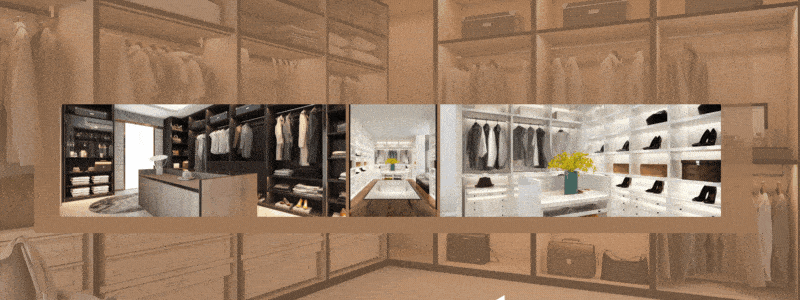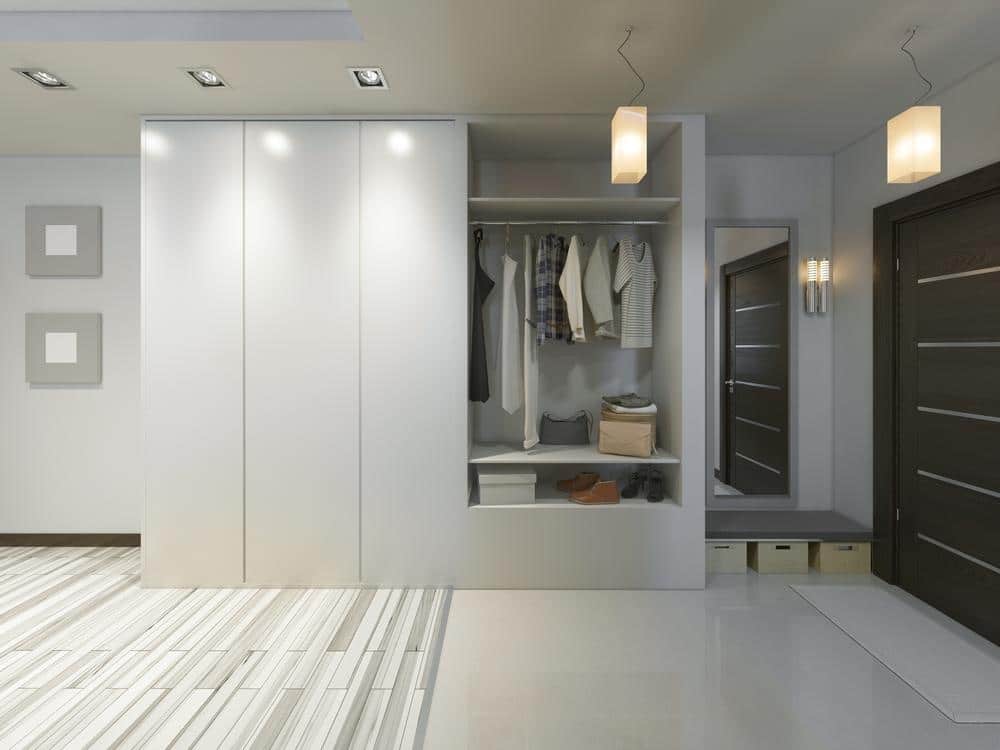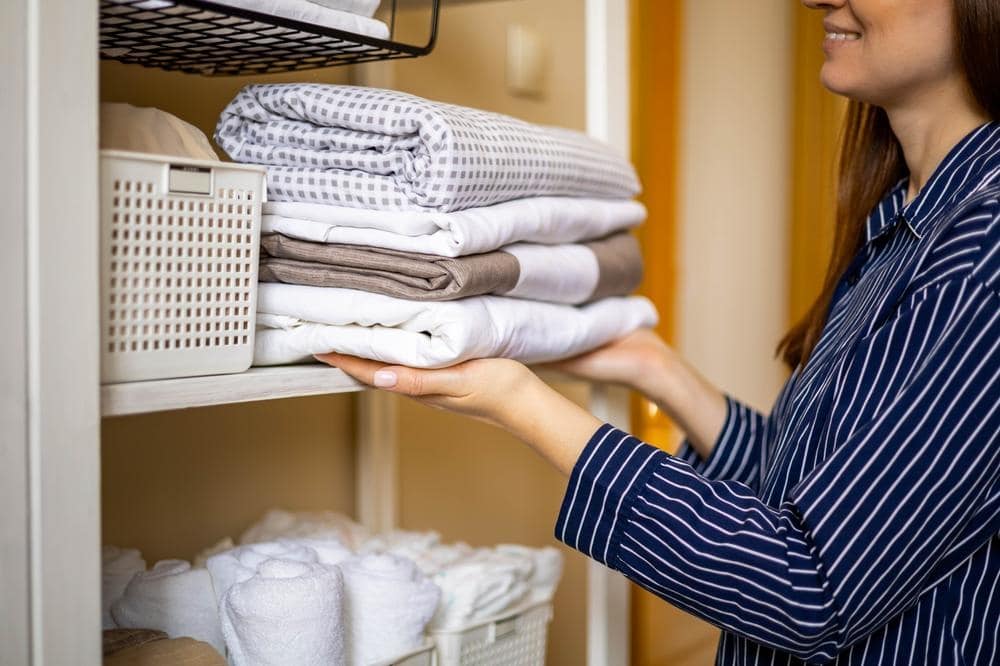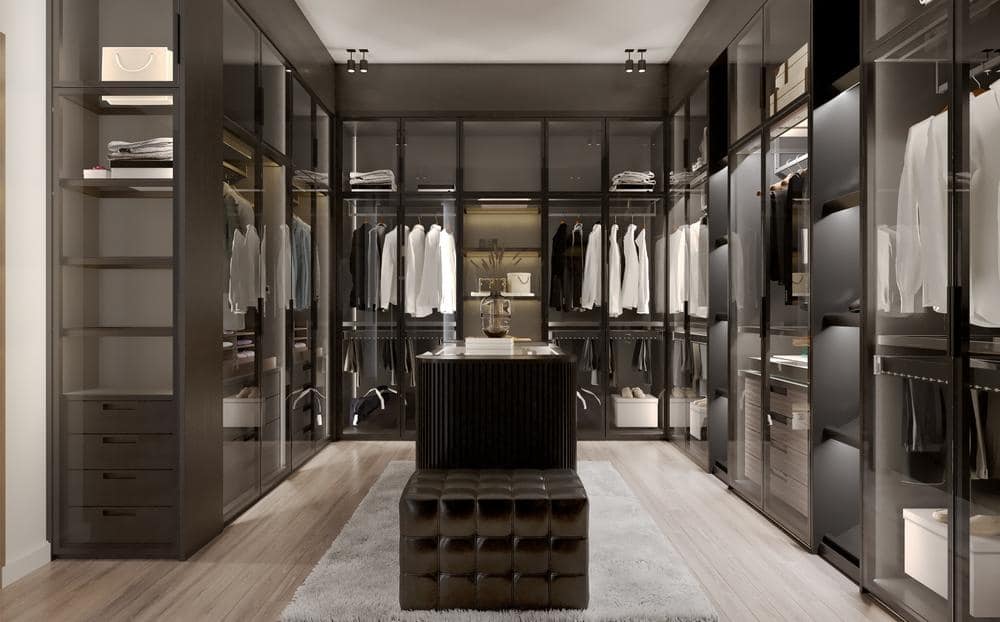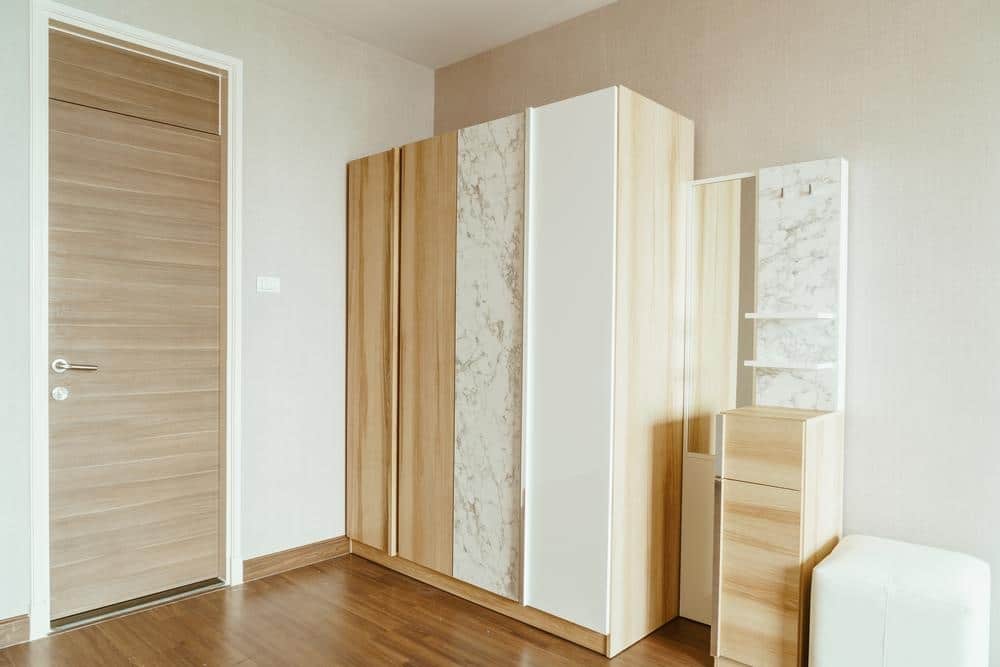Do you dream of having a fantastic wine room to store and enjoy your favorite bottle? Wine rooms can be designed to suit your needs and lifestyle. Here are looking for a modern and sleek design or something more traditional and classic, here are 28 wine room ideas to start your home wine cellar journey.

Traditional Wine Cellar
Table of Contents
- Traditional Wine Cellar
- Wine Cellar Ideas For Small Spaces
- Wine Cellar Design
- Custom Wine Room
- Wine Cellar Ideas
- Wine Fridge
- Glass Doors
- Elegant Wine Cellar
- Wine Cabinets
- Storing Wine
- Create a Wine Room Under the Stairs
- The Secret to a Thriving Wine Room is Climate Control
- Classic Brick Walls With Wood Wine Racks
- Mediterranean Brick Floor With Rustic Basement Wine Cellar
- Unique Wine Storage Designs for All Homes
- Stone Small Wine Cellar With Barrel Tasting Table
- Basement Wine Room Ideas with Wood Ceiling and Walls
- Custom Kitchen Cabinets Make Great Wine Cellars
- Natural Stone Mosaic Tiles
- Traditional Dining Room with Built-in Wine Racks
- Rustic Wine Room Ideas with Multicolored and Slate Floor
- Mountain Style Wine Room With Wood Floor and Vintage Rug
- Modern Wine Room Ideas
- Wine Bar Ideas For Small Spaces
- Wine Room Decorating Ideas
- Glass Wine Room Ideas
- Living Room Wine Bar Ideas
- Wine Cellar Inspiration
- What Should I Put In My Wine Room?
- Does A Wine Room Add Value To A Home?
- What Colors Are Good For Wine Room?
- What Is A Wine Room In A House Called?
- Is It Worth Having A Wine Cellar?
- What Makes A Good Wine Cellar?
- What Else Can I Do With A Wine Cellar?
- What Makes An Ideal Wine Cellar?
- How Much Room Do You Need For 1000 Bottles Of Wine?
- How Much Does It Cost To Install A Small Wine Cellar?
- Is It Ok To Store Wine In The Basement?
- Can You Build A Wine Cellar In Your Basement?
- How Much Does It Cost To Build A Wine Basement Cellar?
- Does Adding A Wine Cellar Increase Home Value?
- How Much Value Does A Wine Cellar Add To A House?
- What Is The Best Way To Store Wine Without A Cellar?
- What Makes A Room A Wine Cellar?
- How Do You Style A Wine Cellar?
- What Should I Put In My Wine Cellar?
- Do Wine Cellars Increase Home Value?
- Can You Put A Rug In A Wine Cellar?
- What Color Is Best For Wine Cellar?
- Does A Wine Cellar Need Ventilation?
- What is the difference between a wine room and a wine cellar?
- What do you need to make a wine room?
- What makes a good wine room?
- What are the different types of wine rooms?
- What do you put in a wine room?
- What color is best for a wine room?
- How big should a wine room be?
- How to design a wine wall?
- How do you light a wine room?
- Does a wine room need to be refrigerated?
- What is the best wine room temperature?
- What is the best wall material for a wine room?
- What Can I Turn a Wine Room Into?
- How Do You Make a Wine Room?
- What is the Cheapest Way to Cool a Wine Room?
- How Do You Cool a Room for Wine Storage?
- What is a Fancy Word for Wine Room?
- Why Do People Have Wine Rooms?
- Can a Wine Room Have a Window?

A traditional wine cellar is a perfect way to create a classic and timeless look for your home. Whether you opt for a full-size room or a smaller wine closet, you can customize the design and style with natural elements such as wooden wine racks, stone walls, and ceilings to create an Old World charm. Your traditional cellar may also include a humidor for storing wine bottles to preserve the freshness and flavor of your favorite vintage. Furthermore, by using a cooling system, you can maintain the optimal temperature for your wine collection.
Wine Cellar Ideas For Small Spaces

Do you have limited space but want to create a luxurious space for your bottles? You can create a dream wine cellar in your home with the right design. Consider vertical spaces like tall wine racks, wall-mounted shelving, or unique racking systems to maximize storage capacity. A small wine cellar can easily be created, even if you have an unused corner in your dining room or an extra closet.
Wine Cellar Design

Whether you design your wine cellar or hire an interior designer, make sure that your cellar reflects your style. You can choose from a modern look with glass doors and sleek wooden cabinets to an elegant space with stone walls and dramatic ceiling treatments. Place a bar table in the center or add a few pieces of contemporary artwork to create a focal point. Whatever design you choose, ensure your wine cellar is an inviting spot for you and your guests to enjoy.
Custom Wine Room
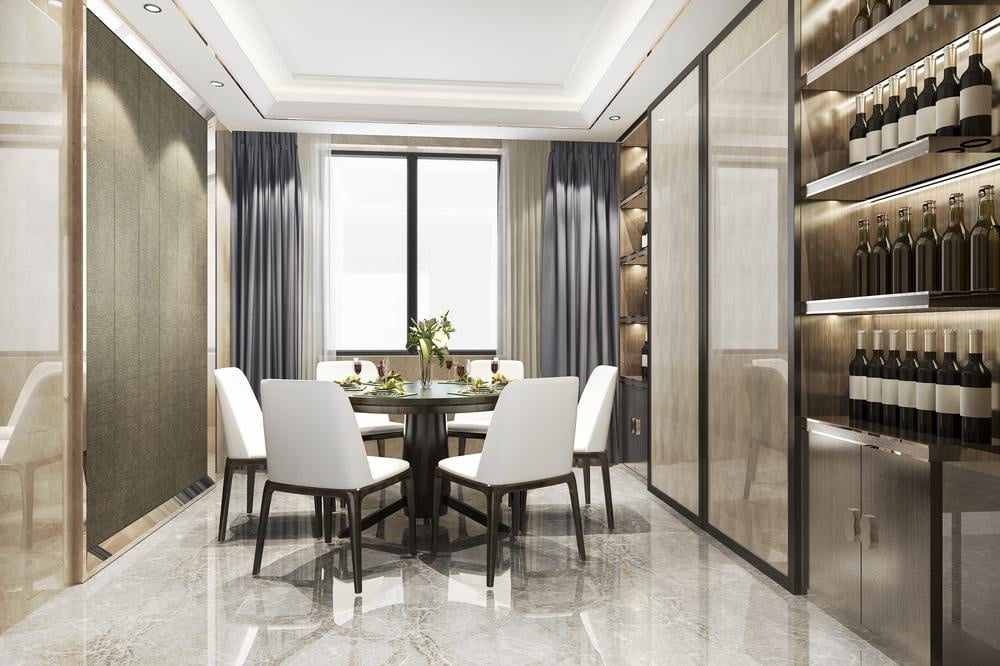
You can create a custom chamber for your precious bottles with a larger budget. With a wine room, you can enjoy a memorable tasting experience with your friends and family. You can have a wet bar and utilize any available space to store bottles with built-in wine racks and cabinets. Consider adding a great-tasting table, comfortable seating, modern lighting fixtures, and artwork to give your wine room a truly luxurious feel.
Wine Cellar Ideas

If you are looking for wine cellar ideas but want to avoid making a substantial financial investment, there are plenty of ways to make a stylish and attractive wine storage space without breaking the bank. Consider using wooden or custom wine racks to store your bottles in a smaller space. You can install a wine fridge or a climate-controlled closet to keep your collection in perfect condition. Utilize any unused space with strategically placed vertical space to maximize your storage capacity.
Wine Fridge
A wine fridge is an excellent option for storing bottles at the perfect temperature in a smaller space. Ensure that the unit is equipped with fans to circulate the cold air throughout the fridge and prevent any potential fluctuations in temperature. The options range from small single-door fridges to full-size, double-door units. For red wine collectors, you can get a dual-zone model so that you can store two types of wine at the same time.
Glass Doors

If you want to showcase your wine collection, install glass doors for your wine cellar. Glass doors can also allow for more light to admire the beauty of your bottles from all angles. Choose from clear, smoked, or frosted glass for added visual appeal.
Elegant Wine Cellar
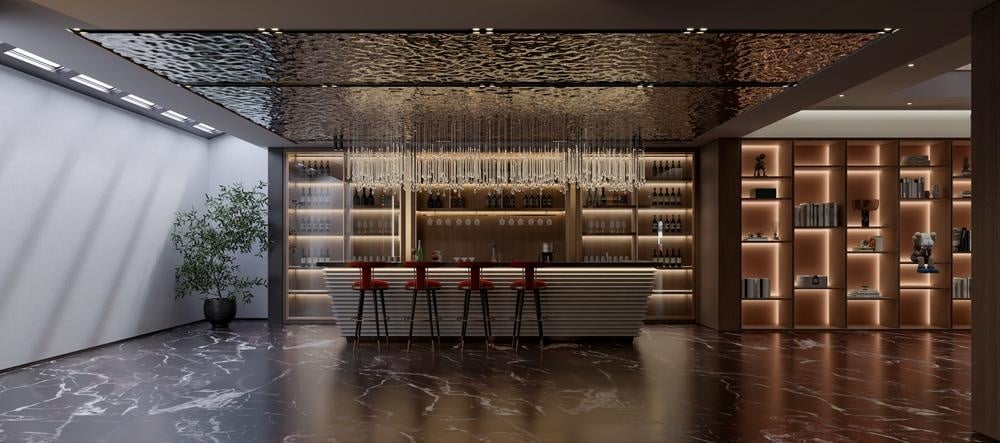
You can get creative with wall and floor designs to give your wine cellar a touch of sophistication and elegance. Create a focal point with a stone wall or wooden ceiling treatment. Alternatively, you can match rich shades of wood paneling with custom wine racks to make a stunning impression.
Wine Cabinets

Wooden cabinets can offer ample storage and organization capabilities if you want a more practical option. They are great for keeping bottles safe and organized. You can also incorporate drawers with bespoke dividers to store corkscrews, glassware, and other wine-related accessories.
Storing Wine

The number one rule of successful wine storage is to keep your bottles in a cool, dark, and vibration-free space. Place the bottles on their side on wooden wine racks to ensure the cork maintains its integrity. Use non-aromatic materials such as wood, stone, and metal for your wine racks and cabinets to protect your bottles. You can install a humidity control system to keep a moist climate within your cellar. With careful consideration and the right design, you can have an excellent wine cellar that your friends and family envy.
Create a Wine Room Under the Stairs
Installing a wine room under the stairs could be a great way to add visual appeal and functionality to your home. With some simple remodeling, you can transform an unused space into a stylish and unique area where you can store and showcase your collection of wines.
Whether contemporary or traditional, adding a wine room will bring life to any living space while increasing its resale value, allowing you to enjoy your wines in a comfortable and inviting atmosphere. With the right touches, this space can serve as a gathering spot for entertaining friends and a quiet corner to relax with a glass of wine.
The Secret to a Thriving Wine Room is Climate Control

Having temperature controlled climate in your wine room is the key to success. The temperature should be consistent at 55 to 58 degrees Fahrenheit with a humidity level between 50 and 70 percent. The slight temperature fluctuates can also be accommodated but keeping it steady within the ideal temperature range is crucial for protecting your wines from cold shock or dehydration.
Furthermore, temperature control will ensure appropriate storage conditions for achieving the best possible maturation of wines over time and prevent spoilage due to overheating. Thus, if you are collecting fine wines, equip your wine room with optimal temperature control systems to enjoy their rich flavors and aromas at their peak.
Classic Brick Walls With Wood Wine Racks
You can easily create an elegant focal point by choosing classic brick walls with wood wine racks. This timeless combination injects sophistication into any space, whether a small dining area or a home office. Not only will your friends be impressed with the instantly recognizable pairing of brick and wood, but they’ll also appreciate its structural integrity – while you relax, knowing that this reliable design won’t look dated in a few years. Investing in classic brick walls with wood wine racks is an easy way to make a lasting impression on guests or give yourself the gift of convenience and security in storing your favorite bottles.
Mediterranean Brick Floor With Rustic Basement Wine Cellar
Rustic elegance meets modern convenience in a Mediterranean brick floor basement wine cellar. The carefully laid brick pattern creates a classic look and seamless transition from floor to wall. Adding stone pillars, rustic cupboards, and wooden accents enhances the antique feel while ensuring successful temperature regulation, so your prized wines age properly.
Enjoy a unique atmosphere for both storage and entertaining with an eye-catching selection of organic materials combined with timeless fixtures. Whether you are passionate about collecting fine wines or appreciate the beauty of brick floors, this basement design will surely add charm and character to your home.
Unique Wine Storage Designs for All Homes

There’s no doubt that wine storage can take up quite a bit of space, so if you’re a wine lover but need an entire cellar for your collection, it pays to think about the best way to store your bottles. Fortunately, many ingenious storage options are available these days; from sleek, temperature-controlled wall-mounted designs to stylishly decorative cabinetry, there’s something perfect for every situation and space.
Allowing you to maximize existing space while creating eye-catching focal points in any home or bar area, unique wine storage designs allow you to keep your favorite bottles stored safely. At the same time, they await appreciation from their lucky consumers.
Stone Small Wine Cellar With Barrel Tasting Table
A small stone wine cellar with a barrel tasting table is an exquisite addition to any kitchen or indoor space. Not only does it create a luxurious and classic ambiance, but it also allows you to store your fine wines with maximum preservation.
This type of cellar is especially beneficial for those who enjoy collecting and sampling different types of wine, as the barrel provides a unique sensory experience when testing out new wines. The tasting table allows one to switch back and forth between several bottles or barrels without getting confused about which one is being sampled. In addition, this type of wine cellar adds an elegant touch to any home while providing an effortless way to display cherished bottles in a timeless style.
Basement Wine Room Ideas with Wood Ceiling and Walls
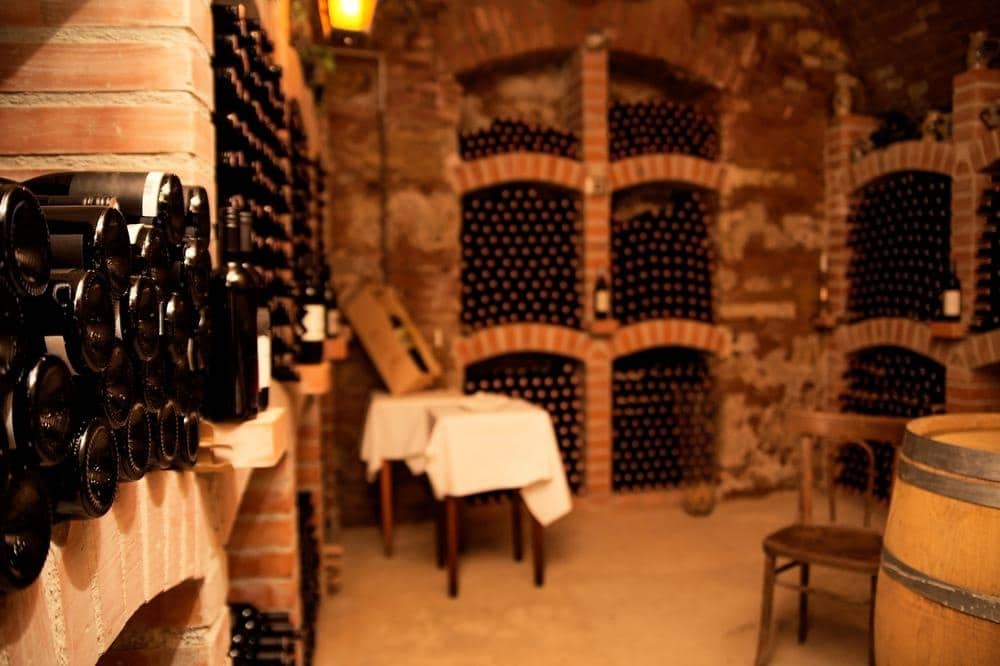
Creating a wine room in your basement can be a great way to bring functionality and style to the area. With a wood ceiling and walls, warmth radiates throughout the space, creating an atmosphere perfect for gathering and entertaining.
Whether you select an existing pre-fabricated design or customize it with unique features, this type of room offers an interior switch-up that suits your taste. From vintage-style lighting arrangements to more modern rack designs, all options for creating a specialized wine room in your basement are available.
Custom Kitchen Cabinets Make Great Wine Cellars
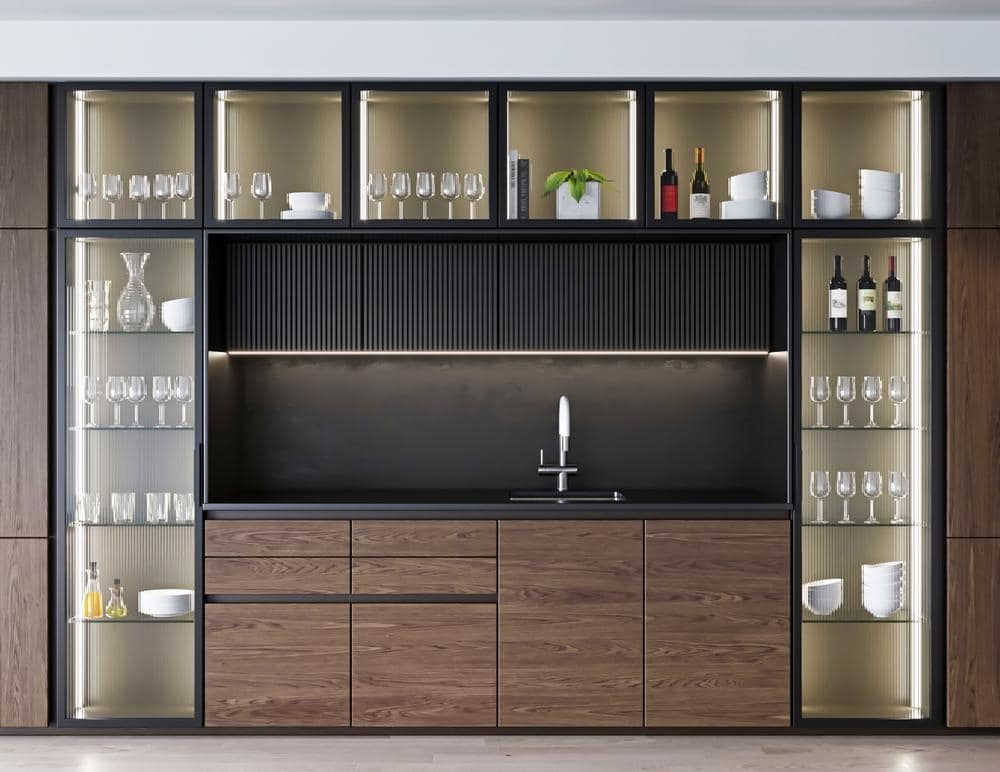
Custom kitchen cabinets make an excellent choice for wine lovers looking to create their cellar. Cabinets can be easily tailored to the size and style of any space, ensuring that you get the perfect storage solution for your treasured collection. In addition, custom cabinets provide maximum protection from temperature swings, light exposure, and other environmental variables that can potentially harm your stored bottles.
Furthermore, cabinets constructed with durable materials are the best bet for maintaining a long-lasting aesthetic worthy of such an investment. For individuals dedicated to their wine selection, choosing custom kitchen cabinets is the ideal way to safeguard it into the future.
Natural Stone Mosaic Tiles
Natural stone mosaic tiles are an exquisite addition to any home. Whether laid on a kitchen backsplash or bathroom walls, these tiles add textural interest by combining stones such as marble, granite, and limestone of different sizes and textures. These tiles come in various shapes like hexagons, rectangles, squares, and dots, creating unique visual allure.
Aside from being attractive and captivating decorative accents that can elevate the aesthetic appeal of any room in the house, natural stone mosaic tiles also offer a powerful feature – durability that is resistant to scratches, water damage, or fading over time. Their age-old allure has been sought after for centuries in homes worldwide because of their timeless beauty, enhancing interior design projects with sophistication.
Traditional Dining Room with Built-in Wine Racks
A traditional dining room is perfect for enjoying enjoyable meals with family and friends. Adding built-in wine racks to the design will only enhance the experience of every dinner, party, or get-together in that room. Not only are these racks aesthetically pleasing, but they can also provide extra storage for your favorite bottles and glasses. Creating a unique dining spot celebrating food and wine will help you transform any mealtime into an unforgettable event!
Rustic Wine Room Ideas with Multicolored and Slate Floor
Step into the cozy, wine-inspired rustic room of your dreams with our thoughtfully designed flooring. All eyes will be immediately drawn to the gleaming multicolored slate tiles, which draw attention and make this unique space an ideal place to relax with a bottle of your favorite vintage.
Whether you’re hosting a formal gathering or just enjoying some downtime in your home, let the beauty of our rustic wine room transport you to another world. The warm shades and earthy tones create a vibrant, inviting atmosphere that encourages conversation and camaraderie among guests. Complete the look by adding rustic furniture and accents to make it the perfect escape for any occasion.’
Mountain Style Wine Room With Wood Floor and Vintage Rug
Ignite your interior design with a luxurious mountain-style wine room. This inviting atmosphere is perfect for hosting guests or settling in for an evening at home, featuring deep, dark wood flooring paired with an earthy, vintage rug.
This room has everything you need to experience the beauty of living with your mini winery. It is functionally convenient and aesthetically pleasing for all your storage needs, creating a beautifully crafted and detailed space. Whether you’re entertaining family or friends, this meticulously crafted room provides extra sophistication to any get-together.
Modern Wine Room Ideas

Modern wine rooms perfectly balance grandeur, convenience, and atmosphere. Whether you want a whole room dedicated to cellar storage or would instead turn a corner of a library or ballroom into an elegant display, modern wine rooms can be great additions to any interior décor. With the right design, you can create an aesthetically pleasing space for severe connoisseurs and casual tasters.
Take advantage of decorative and multipurpose racks, contemporary island designs with built-in coolers, and other features like tasting bars and illuminated wine displays – these elements will make your room truly unique while still conveying a classical atmosphere.
Wine Bar Ideas For Small Spaces
When hosting a gathering in a small space, having the right wine bar can make all the difference. You can create a tasteful and convenient guest experience with a few inventive ideas. Start by selecting furniture pieces that can double as storage for your collection of wines, like a buffet or cabinet with shelves and drawers.
Then find an upcoming trend in drinkware, such as stemless glasses or stemless carafes. Finally, invest in modern accessories such as foldable tables and drink holders that provide style and practicality! With these tips, you’ll have a stylish and efficient wine bar fit for any small space.
Wine Room Decorating Ideas

Decorating a wine room can be an exciting endeavor for any wine enthusiast. A well-designed space can provide the perfect backdrop to showcasing your favorite wines and add to the appreciation of a good bottle.
Whatever design elements you choose, let them encompass your style while accentuating the beauty of those delicious bottles of wine! Start by choosing a color scheme; pick colors that tend to be subtle, like earthy tones, since bolder hues may overshadow the elegance of the wines you display. Hang an exciting piece of art that highlights the theme of your room and incorporates lighting, which brings out qualities in the finished product.
Glass Wine Room Ideas
Decorating a glass wine room can be a great way to show off your collection of vintage wines. By selecting an all-glass enclosure for the room, you can create a beautiful atmosphere that will instantly add character and class to any home.
You can create your home’s ultimate glass wine room with creative design choices and a commitment to quality materials. When considering materials for such an ambitious project, it’s essential to consider options like double-glazed tempered glass, which provides excellent soundproofing and insulation. Additionally, elegant finishes like bronze or stainless steel cladding and door frames can unite the space.
Living Room Wine Bar Ideas

Setting up a wine bar at home can be a great way to entertain guests and add an extra level of sophistication to your living room. From finding the perfect furniture piece to choosing the proper glassware, there are several elements to consider when concocting a chic yet comfortable atmosphere for your living room wine bar.
Incorporating personal touches such as memorabilia or unique lighting can also help create that inviting ambiance you’re after. Whether you go for a full-blown bar design or something low-key, rearranging your living room with a wine bar in mind can reap impressive rewards.
Wine Cellar Inspiration
Delving into the possibilities of a wine cellar is an exciting venture! You can use the space to house not only vintage selections but also a variety of creative statement pieces. Colorful accent shelving, modern LED lighting, and detailed solutions for the organization – all these elements craft stunning displays which bring great joy to those passionate about their vintages. With so many options for customization and personalization, a well-designed wine cellar has the potential to become the most exciting part of any home.
What Should I Put In My Wine Room?
A wine room is a great way to store and showcase your wine collection. Here are some things you may want to consider putting in your wine room:
Wine racks: This is the most important feature of any wine room. You need a good set of wine racks to keep your bottles organized. Many types of wine racks are available, from wall-mounted to floor-standing, and you can choose one that suits your needs and style.
Temperature and humidity control: Wine is a delicate drink that needs to be stored in the right environment. A wine room should have temperature and humidity control systems to maintain the ideal conditions for wine storage.
Lighting: Proper lighting can make your wine room look even more impressive. You can use LED lights to highlight your wine collection or softer lighting to create a cozy atmosphere.
Tasting area: A wine room can also be a great place to entertain guests. Consider adding a small tasting area with a table and chairs where you can sample your wines.
Wine glasses and accessories: To fully enjoy your wine, you need the right glasses and accessories. You should keep wine glasses, decanters, and corkscrews in your wine room.
Artwork and decor: A wine room can also be a great place to display artwork and decor that reflects your style and personality. You can hang paintings, install a chandelier, or add other decorative elements to make your wine room feel like a luxurious retreat.
Remember that your wine room should be tailored to your preferences and needs. It should be a space you enjoy spending time in and showcase your wine collection in the best possible way.
Does A Wine Room Add Value To A Home?
A wine room can add value to a home, particularly for buyers who appreciate wine and entertaining guests. A wine room can be seen as a luxury feature and an attractive selling point for potential buyers.
A wine room can also be viewed as a functional addition to a home. It provides a designated space for storing and aging wine properly, which is important for wine enthusiasts. A wine room can also help keep wine at a consistent temperature and humidity level, which can help preserve its quality over time.
However, it is essential to note that the value added by a wine room will depend on various factors, such as the size and quality of the wine room, the location of the home, and the preferences of potential buyers. A well-designed, well-maintained wine room can enhance a home’s appeal and value.
What Colors Are Good For Wine Room?
When it comes to choosing colors for a wine room, there are a few options that work well:
Rich, Warm Colors: Consider using warm, rich colors like deep red, burgundy, or brown. These colors can create a cozy, inviting atmosphere that is perfect for relaxing and enjoying a glass of wine.
Neutral Colors: Neutral colors like beige, cream, or gray can provide a clean and sophisticated backdrop for displaying wine bottles and accessories. Neutral colors can also complement the natural tones of wood and stone, commonly used in wine room design.
Dark Colors: To create a dramatic, elegant look in your wine room, consider using dark colors like black, navy blue, or dark green. These colors can create a sense of depth and sophistication and can be paired with metallic accents for added visual interest.
Ultimately, the color scheme you choose for your wine room will depend on your style and the overall design of your home. It is essential to choose colors that complement the wine bottles and accessories you plan to display and create a comfortable and inviting space for you and your guests.
What Is A Wine Room In A House Called?
A wine room in a house can be called a few different names depending on its location, size, and purpose. Some common names for a wine room in a house include:
Wine Cellar: A wine cellar is typically a dedicated, climate-controlled space in the basement or lower level of a home designed specifically for storing and aging wine.
Wine Room: A wine room can refer to any homeroom designed to store and display wine bottles and accessories. Wine rooms can be located on any level of a home and may or may not be climate-controlled.
Wine Closet: A wine closet is a smaller, enclosed space to store and display wine bottles. Wine closets are typically located in a spare room, pantry, or closet and may or may not be climate-controlled.
Ultimately, the name you choose for your wine room will depend on the space’s size, location, and purpose and your personal preference.
Is It Worth Having A Wine Cellar?
A wine cellar can be worth it if you are a wine enthusiast with a collection of wine you want to store and age appropriately. A wine cellar provides a dedicated space to store wine at the ideal temperature and humidity, which can help to preserve the quality and flavor of the wine over time.
What Makes A Good Wine Cellar?
Several factors contribute to making a good wine cellar:
Proper Temperature and Humidity: Wine should be stored at a consistent temperature between 45-65°F (7-18°C) and humidity levels between 60-75%. A wine cellar should have a cooling system to maintain the ideal temperature and humidity levels.
Adequate Insulation: A wine cellar should be well-insulated to maintain a consistent temperature and prevent temperature fluctuations that can damage the wine.
Proper Lighting: Wine should be stored in a dark environment to prevent the degradation of flavors and colors. A wine cellar should have minimal lighting, with a red or amber light used for navigation.
Appropriate Storage System: Wine bottles should be stored horizontally to keep the cork moist and prevent oxidation. A wine cellar should have an appropriate storage system, such as racks, shelves, or bins that accommodate different bottle sizes and shapes.
Ventilation: Proper ventilation ensures air circulates through the wine cellar, preventing mold and mildew buildup.
What Else Can I Do With A Wine Cellar?
While a wine cellar is typically designed for storing and aging wine, there are several other ways you can use the space:
Wine Tasting Room: A wine cellar can be transformed into a wine tasting room, providing a comfortable and elegant space to enjoy wine with friends and family. Consider adding seating, a table, and appropriate glassware to create a wine-tasting experience.
Home Bar: A wine cellar can also be converted into a home bar, complete with a countertop, sink, and refrigerator. This can provide a dedicated space for mixing and serving drinks, with easy access to wine stored in the cellar.
Wine Storage and Display: A wine cellar can still store and display wine if you need an extensive collection. Consider adding lighting and shelving to showcase your favorite bottles.
Home Theater: A wine cellar can also be converted into a home theater, providing a cozy and intimate space to watch movies or TV shows. Consider adding comfortable seating and soundproofing materials to create the ultimate entertainment experience.
What Makes An Ideal Wine Cellar?
An ideal wine cellar is designed to ensure your wine bottles are stored in the best possible environmental conditions to ensure their longevity and quality. This includes aspects such as temperature, humidity, and light control.
Temperature: The temperature in the wine cellar should be between 53°F and 57°F (12°C and 14°C). Keeping your wine at a consistent temperature, You should avoid any sudden fluctuations as much as possible.
Humidity: The ideal humidity should be between 50-70% to keep your corks from drying out and prevent spoilage. Too much humidity can cause mold growth, while too little humidity can dry out the corks, allowing oxygen in and spoiling the wine.
Light can damage wine, so keeping your wine cellar away from direct sunlight is essential. You should keep natural or artificial light to a minimum to protect the quality of your wine.
How Much Room Do You Need For 1000 Bottles Of Wine?
The amount of room needed for 1,000 bottles of wine will depend on the size and shape of the bottle. Generally speaking, a 750ml bottle of wine will take up about 0.7 cubic feet of storage space. This means that for 1,000 bottles, you will need about 700 cubic feet of storage space. This is equivalent to about 20 square feet or an area the size of a standard bedroom closet.
If you are storing the bottles in wooden crates, you will need slightly more space due to the width of the crates. For 1,000 bottles in crates, you will need about 30 square feet or the size of a small bedroom.
When storing wine, it’s important to remember that the bottles need to be stored upright and not on their sides, as this can affect the quality of the wine. You will also need to ensure your storage area is climate-controlled to prevent damage to the wine. An ideal temperature range for storing wine is 55-58 degrees Fahrenheit with a relative humidity of around 60-70%.
How Much Does It Cost To Install A Small Wine Cellar?
The cost of installing a small wine cellar will depend on several factors, including the project’s size, location, materials, and complexity. Installing a small wine cellar will range from about $4,000 to $15,000.
The size of the wine cellar will be the primary factor in determining cost. A small wine cellar typically ranges from 20-200 cubic feet, with the average size being around 100 cubic feet. The cost will vary depending on the size of the space, with larger spaces generally requiring more materials and higher labor costs.
Location is also important to consider when budgeting for a small wine cellar. A wine cellar in a basement or another climate-controlled area will generally require less insulation, as these areas maintain a consistent temperature. However, a wine cellar in an outdoor area will require more insulation and will likely cost more to install.
The type of materials used in the wine cellar will also impact the cost. An essential wine cellar will usually include drywall, insulation, and shelving. Higher-end materials such as cork walls and marble flooring will increase the cost. Additionally, the complexity of the project will also affect the cost. For instance, installing a self-contained cooling system will require more materials and labor and be more expensive than a simple shelving system.
In summary, the cost of installing a small wine cellar will vary depending on the project’s size, location, materials, and complexity. Installing a small wine cellar will range from $4,000 to $15,000.
Is It Ok To Store Wine In The Basement?
Yes, it is ok to store wine in the basement as long as the basement is kept at an optimal temperature and humidity. Wine should be stored where the temperature is between 45-65 degrees Fahrenheit, and the humidity is between 50-70%. A basement can provide a cool, dark, and controlled environment ideal for storing wine. However, basements can be prone to fluctuations in temperature and humidity, so it is essential to monitor the basement’s temperature and humidity levels to ensure they stay within the optimal range.
Can You Build A Wine Cellar In Your Basement?
Yes, it is possible to build a wine cellar in your basement. Depending on the size and layout of your basement, you can create a temperature and humidity-controlled space for storing wine.
The first step to creating a wine cellar in your basement is to determine how much space you have available to work with. You’ll also need to consider factors such as temperature, humidity, and light and how they will affect the wines stored in the cellar.
Once you have chosen a suitable space, the next step is to insulate and seal the walls and floors. You will want to use a water- and temperature-resistant material such as cork, foam, or stone. You will also need to install a cooling system for the cellar to maintain a constant temperature of between 50-55°F. Additionally, you must install an exhaust system to keep the humidity level between 50-70%.
How Much Does It Cost To Build A Wine Basement Cellar?
The cost of building a wine cellar in a basement can vary widely depending on the size of the cellar, the materials used, and other factors. If you hire a professional to build your wine cellar, costs can range from $10,000 to $100,000 or more, depending on the size of the cellar, the materials used, and the project’s complexity.
Does Adding A Wine Cellar Increase Home Value?
Yes, adding a wine cellar to a home can increase its value. A wine cellar adds a sense of luxury and sophistication to a home and can create a great conversation piece. Adding a wine cellar can make a home more desirable to potential buyers and be a unique selling point.
That said, it’s essential to consider the cost of building a wine cellar. Wine cellars require specialized knowledge and expertise to be installed properly. Therefore, it’s essential to consider the cost of building a wine cellar before adding a home.
How Much Value Does A Wine Cellar Add To A House?
The values a wine cellar can add to a house vary widely and depend on location, quality, size, and market demand. However, a well-designed and adequately installed wine cellar can add anywhere from a few thousand dollars to tens of thousands of dollars to a home’s value.
What Is The Best Way To Store Wine Without A Cellar?
The best way to store wine without a cellar is in a cool, dark, and humid place with a consistent temperature between 45-65°F (7-18°C). This could be a closet, cabinet, or even under a bed, as long as the environment is not subject to frequent temperature fluctuations or direct sunlight. You should also store wine horizontally to keep the cork moist and prevent it from drying out.
What Makes A Room A Wine Cellar?
A room can be considered a wine cellar if designed to store wine properly, with temperature control, proper ventilation, and appropriate storage solutions. It should maintain a consistent temperature between 45-65°F (7-18°C), be dark, and have a humidity level of around 60-70%. The room should also have wine racks or other storage solutions that keep the bottles horizontal to keep the cork moist.
How Do You Style A Wine Cellar?
Styling a wine cellar involves creating a functional and aesthetically pleasing space that complements your home’s décor. Here are some tips for styling a wine cellar:
Lighting: Use low-level lighting to create a warm and inviting atmosphere in the wine cellar.
Colors: Use a neutral color palette, such as shades of white, grey, or brown, to create a classic and timeless look.
Materials: Use natural wood or stone to create a rustic and elegant feel.
Wine Racks: Choose wine racks that fit the room’s style and are functional for storing wine bottles.
Artwork and Décor: Add artwork, mirrors, or other decorative elements to create visual interest and enhance the space.
The key is to balance functionality with aesthetics to create a beautiful and practical wine cellar.
What Should I Put In My Wine Cellar?
A wine cellar should be stocked with wines intended for long-term storage, such as high-quality red wines, vintage ports, and champagnes. It is also a good idea to include a variety of wines from different regions, varietals, and vintages to appeal to a range of tastes. Consider your personal preferences and the types of wines you plan to collect or age, and make sure to organize and label each bottle for easy access properly. Consider storing other wine-related items in your wine cellar, such as glassware, decanters, and wine openers.
Do Wine Cellars Increase Home Value?
Yes, wine cellars can increase a home’s value. A well-designed and properly installed wine cellar can add anywhere from a few thousand dollars to tens of thousands of dollars to a home’s value, depending on factors such as location, size, quality, and market demand. However, the added value can vary widely depending on the specific circumstances of the home and the local real estate market.
Can You Put A Rug In A Wine Cellar?
Putting a rug in a wine cellar is generally not recommended since it can trap moisture and create an environment that is not ideal for storing wine. Wine cellars should be kept at a consistent temperature and humidity level, and any flooring used should be resistant to moisture and easy to clean. If you want to add warmth and softness to the space, consider using an area rug made from moisture-resistant materials, such as wool or synthetic fibers.
What Color Is Best For Wine Cellar?
The best color for a wine cellar is a neutral color palette, such as shades of white, gray, or brown. Neutral colors create a timeless and classic look and allow the focus to be on the wine. Additionally, lighter colors help reflect light in the space and make it feel brighter and more open. However, it is essential to avoid bold or bright colors that can reflect onto the wine bottles and affect their temperature.
Does A Wine Cellar Need Ventilation?
Yes, a wine cellar needs ventilation to maintain the proper humidity levels and air quality. Proper ventilation allows fresh air to circulate into the space, preventing the buildup of musty odors, mold, or mildew. It also helps to regulate the humidity levels, which should be around 60-70%, to keep the cork moist and prevent it from drying out. A wine cellar can be ventilated through a passive or active system, such as vents or fans, depending on the design and size of the space.
What is the difference between a wine room and a wine cellar?
A wine room and cellar may sound like they serve the same purpose but they are pretty different. A wine or tasting room is generally part of a larger structure, such as a property or winery. It houses the tasting area with racks to store bottles of wines and often includes seating for customers who wish to learn more while they taste. On the other hand, a wine cellar is typically used to age and store wines long-term.
With these specialty considerations designed to create optimal storing conditions for aging wines, it is clear that a wine cellar’s purpose goes beyond just holding bottles of wine; it facilitates the aging process itself. It’s often constructed offsite in an underground location, such as in a basement or beside the house, and usually has climate control capabilities so that the temperature remains constant. The ideal humidity should also be around 70 percent.
What do you need to make a wine room?
To create a wine room, you’ll need the following:
- A designated space: Choose a suitable location with minimal temperature fluctuations and minimal exposure to direct sunlight.
- Insulation and vapor barrier: Proper insulation and a vapor barrier will help maintain consistent temperature and humidity levels.
- Climate control system: Install a cooling system or wine cellar cooling unit to regulate temperature and humidity.
- Wine racks or shelving: Select appropriate storage solutions for your wine collection, such as modular racks, custom-built shelves, or wall-mounted holders.
- Lighting: Incorporate energy-efficient LED lighting that won’t generate heat or UV rays.
- Flooring: Choose suitable flooring materials like tile, stone, or sealed concrete that can withstand moisture and temperature fluctuations.
- Door: Install a well-insulated door with weather stripping to maintain climate stability.
What makes a good wine room?
A good wine room should have:
- Consistent temperature and humidity levels: Ideal conditions are 55-60°F (13-16°C) and 60-70% relative humidity.
- Minimal exposure to sunlight: Protect your wine from harmful UV rays by avoiding direct sunlight or using UV-resistant glass.
- Proper ventilation: Ensure adequate air circulation to prevent mold and musty odors.
- Functional wine storage: Use wine racks or shelving that maximizes storage space and allows for easy access.
- Aesthetic appeal: Create a visually appealing environment with attractive lighting, artwork, and design elements.
- Security: Consider installing a lock on the door or incorporating a security system to protect your investment.
What are the different types of wine rooms?
There are several types of wine rooms, including:
- Built-in wine rooms: Dedicated spaces constructed within a home, often in basements or unused rooms.
- Wine cellars: Underground spaces specifically designed for wine storage, providing natural insulation and consistent conditions.
- Wine cabinets: Standalone, temperature-controlled units that resemble furniture and can be placed in various areas of a home.
- Wine closets: Small, converted spaces, such as under-stair storage or walk-in closets, outfitted for wine storage.
What do you put in a wine room?
In a wine room, include the following elements:
- Wine racks or shelving
- Climate control system
- Insulated door with weather stripping
- Proper lighting
- Comfortable seating or tasting area (optional)
- Artwork or decorative elements
- Glassware and accessories storage
What color is best for a wine room?
The best colors for a wine room are typically darker shades that evoke a sense of warmth and intimacy. Consider hues like deep reds, burgundy, navy blue, charcoal gray, or dark brown. Avoid bright colors, as they may interfere with the perception of wine colors during tastings.
How big should a wine room be?
The ideal size for a wine room depends on your collection and available space. A small wine room can be as compact as 25-50 square feet, while larger rooms may exceed 200 square feet. Consider your current collection size, potential growth, and any additional features you’d like to include, such as seating or a tasting area.
How to design a wine wall?
Designing a wine wall involves the following steps:
- Measure the wall space and determine the number of bottles you want to store.
- Choose a wine storage system, such as wall-mounted racks, floating shelves, or modular panels.
- Plan the layout, considering factors like bottle visibility, accessibility, and visual appeal.
- Select materials and finishes that complement your room’s design aesthetic.
- Install the wine storage system securely, following manufacturer guidelines.
How do you light a wine room?
Light a wine room with energy-efficient LED lighting that doesn’t generate heat or UV rays. Consider options like recessed ceiling lights, track lighting, LED strip lights for accent lighting, or wall sconces to create an inviting atmosphere.
Does a wine room need to be refrigerated?
Yes, a wine room should maintain a consistent temperature between 55-60°F (13-16°C) to preserve the quality and longevity of the wine. A climate control system or wine cellar cooling unit is necessary to regulate temperature and humidity levels.
What is the best wine room temperature?
The ideal temperature for a wine room is between 55-60°F (13-16°C), which helps maintain the wine’s quality, flavor, and aging potential.
What is the best wall material for a wine room?
The best wall materials for a wine room include:
- Insulated drywall: Provides thermal insulation and moisture resistance.
- Stone or brick veneer: Adds an attractive, rustic aesthetic while maintaining temperature stability.
- Wood paneling: Creates a warm, classic look and can be treated for moisture resistance.
- Moisture-resistant cement board: Offers durability and resistance to mold and mildew.
Regardless of the material, ensure proper insulation and a vapor barrier are installed to maintain
What Can I Turn a Wine Room Into?
A wine room can be transformed into several functional spaces depending on your needs and interests. For food enthusiasts, it could become a cheese or cured meat cellar. If you’re into preserving food, you could use it for storing homemade cans or jars. It could even be a dedicated storage area for homemade kimchi and soy sauce. Alternatively, you could convert it into a tasting room for various beverages, not just wine.
How Do You Make a Wine Room?
Making a wine room involves several steps:
- Select a Location: Choose a space that’s cool and away from direct sunlight.
- Insulate the Room: Proper insulation is crucial to maintain the right temperature and humidity.
- Install a Cooling System: A specialized wine cooling system will help keep the temperature steady.
- Add Wine Racks: These could be wall-mounted, freestanding, or custom-built to fit the room.
- Decorate: Personalize the space with stylish decor, comfortable seating, and appropriate lighting.
What is the Cheapest Way to Cool a Wine Room?
The cheapest way to cool a wine room is to strategically choose its location in a naturally cool and dark place, like a basement, which reduces the need for artificial cooling. Using insulation materials such as foam board or fiberglass can also help maintain the temperature.
How Do You Cool a Room for Wine Storage?
To cool a room for wine storage, you can install a wine cellar cooling unit, which is designed to maintain the optimal temperature and humidity for wine. Additionally, insulating the room properly and keeping it away from direct sunlight can help keep it cool.
What is a Fancy Word for Wine Room?
A fancy word for a wine room is a “wine cellar” or “wine vault”. These terms often refer to a dedicated space for storing and aging wine.
Why Do People Have Wine Rooms?
People have wine rooms for several reasons. Wine rooms provide the optimal conditions for storing and aging wine, enhancing its flavor over time. They also provide an impressive display for a wine collection and can serve as a unique space for entertaining guests.
Can a Wine Room Have a Window?
While it’s possible for a wine room to have a window, it’s generally not recommended because sunlight can damage wine. If a window is necessary, it should be well-insulated and fitted with UV-resistant glass to protect the wine from light and temperature fluctuations.

Experienced Executive Assistant with a demonstrated history of working within the furniture industry. Skilled in furniture styling, visual communication, project management, and proficiency with Adobe Creative Suite. Strong arts and design professional with a (BA) Creative Direction for furniture design focused on Industrial Design from School of the Art Institute of Chicago.



